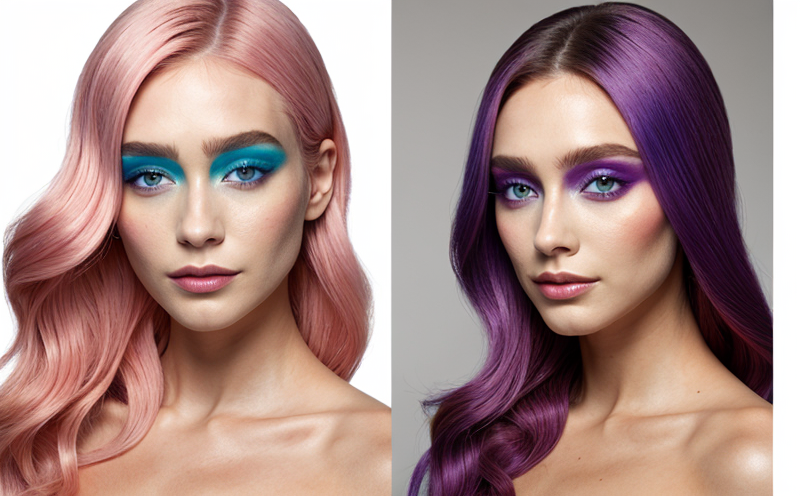Color Fastness Testing in Cosmetic Products
Color fastness testing is a critical component of cosmetic product development and quality control. It ensures that colorants used in cosmetics, such as lipsticks, foundation creams, eyeshadows, and nail polishes, retain their color integrity throughout various environmental conditions and during regular use by consumers.
The primary goal of color fastness testing is to prevent the undesirable transfer or fading of colors from one cosmetic product to another, thereby maintaining consumer satisfaction and trust in the brand. This service plays a pivotal role in ensuring compliance with international standards such as ISO 105-D02, which provides guidelines for evaluating the resistance of dyed textiles to rubbing.
For quality managers, color fastness testing is essential for maintaining consistent product quality across production batches and ensuring that cosmetic products meet regulatory requirements. Compliance officers rely on this service to ensure that their products comply with global standards and regulations such as those set by the European Union (EU) Cosmetics Regulation.
R&D engineers leverage color fastness testing to innovate new formulations, optimize product performance, and identify potential issues early in the development process. Procurement teams benefit from this service by ensuring that raw materials and pigments used meet stringent quality criteria before incorporation into final products.
During the cosmetic production process, it is common for colorants to come into contact with various substrates like skin, hair, fabrics, or other cosmetics during application. It's crucial to assess how these interactions affect the color stability of the product. This testing helps identify any potential risks associated with color transfer and provides actionable insights for improving product performance.
Color fastness tests can be conducted under different conditions that simulate real-world usage scenarios, such as dry rubbing, wet rubbing, perspiration, light exposure, or mechanical friction. These tests help determine the durability of colors in various environments and against common contaminants like sweat or dirt.
The testing process typically involves applying a specific amount of colorant onto a substrate material (such as cotton fabric) and then subjecting it to one or more types of stressors depending on the type of product being tested. After exposure, the sample is evaluated visually by comparing its appearance before and after treatment.
| Test Method | Description |
|---|---|
| ISO 105-D02 (Rubbing Fastness) | This method evaluates the resistance of dyed textiles to rubbing by mechanical means. It simulates the transfer of color from one fabric to another during normal wear and tear. |
| ISO 105-G03 (Perspiration Fastness) | This test assesses the stability of colors in the presence of perspiration, which can lead to fading or color transfer on the skin. It simulates typical sweat conditions encountered during daily use. |
| ISO 105-B02 (Light Fastness) | This method determines the resistance of dyed textiles to light exposure, which can cause fading over time. This is particularly important for cosmetic products that may spend extended periods exposed to sunlight. |
Applied Standards
The color fastness testing of cosmetic products must adhere to several international standards to ensure product safety and efficacy. The most widely recognized standard for this purpose is ISO 105, which provides a comprehensive framework for evaluating the resistance of dyed textiles to various environmental factors.
- ISO 105-D02: Resistance to rubbing
- ISO 105-G03: Resistance to perspiration
- ISO 105-B02: Resistance to light
- ASTM D695 (Standard Test Method for Color Fastness of Textile Fabrics)
Compliance with these standards ensures that the cosmetic products meet rigorous quality benchmarks and are safe for consumer use. By adhering strictly to these guidelines, laboratories can provide accurate results that reflect real-world performance.
Industry Applications
Color fastness testing finds application across various segments within the cosmetic industry:
- Lipstick and lip gloss manufacturers need to ensure their products do not transfer color onto other cosmetics or onto the skin.
- Eyeshadow producers must guarantee that their pigments remain vibrant without transferring to eyeliner or mascara.
- Nail polish companies aim to prevent color transfer from nails to cuticles, surrounding skin, and undergarments.
The results of these tests are not only used internally but also shared with regulatory bodies and customers. They provide valuable data that can influence product development decisions, improve marketing strategies, and enhance brand reputation.
Competitive Advantage and Market Impact
- Enhanced consumer trust: By ensuring color stability, companies build stronger relationships with their customers.
- Increased product longevity: Products that maintain their appearance better are more likely to retain customer loyalty over time.
- Better compliance with regulations: Meeting international standards helps avoid potential legal issues and fines.
- Innovation opportunities: Understanding color fastness limitations allows for the development of new formulations that surpass current market offerings.





